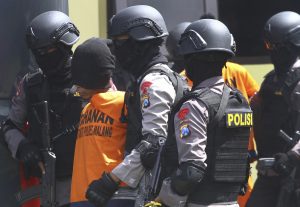On September 11, 2001, four planes were hijacked and crashed into the twin towers of the World Trade Center in New York City, the Pentagon outside Washington, D.C., and (after passengers and crew fought back) into a field in rural Pennsylvania. More than 2,700 people died, most of them in New York when the towers collapsed. It was the deadliest terrorist attack on U.S. soil.
9/11 changed the focus of U.S. foreign policy seemingly overnight. After the attacks, the U.S. government focused nearly all of its national security efforts, and much of its diplomacy as well, on eradciating terrorism. The “Global War on Terror” (GWOT) was born.
The opening salvo in the GWOT was, of course, the U.S. invasion of Afghanistan, where al-Qaida, the terrorist group behind 9/11, was being sheltered by the Taliban regime. The U.S. invaded Afghanistan in October 2001 and swiftly overthrew the Taliban, but did not succeed in killing the mastermind of 9/11, Osama bin Laden, until May 2011 (in a surprise raid into neighboring Pakistan where he was hiding). The GWOT’s original conflict – the “good war” in Afghanistan – was set to end by the 20th anniversary of 9/11 with the withdrawal of U.S. troops. But the withdrawal precipitated the rapid collapse of the U.S.-backed Afghan government and the triumphant return of the Taliban to power in Kabul.
We’ll have plenty on the tragic end of the U.S. war in Afghanistan later in this issue, but as Sean Roberts writes, the GWOT had far-reaching consequences beyond the direct impact of the “forever wars” in Afghanistan and Iraq:
It created a global consensus that the human rights of “terrorists” should be suspended in the interest of global security while simultaneously leaving the definition of “terrorists” vague enough to allow states latitude in determining who within their borders should be labeled as such. Subsequently, states around the world have found it advantageous to label a variety of domestic opponents, if they are Muslim, as “terrorists” to justify the unfettered abuse of their rights. Although the international community did not necessarily promote such actions, it did help facilitate them by agreeing to list, often in the interests of politics, a broad array of Muslim political actors on international “terrorism lists.” This would have negative implications for a variety of Muslim political forces as well as for many marginalized Muslim ethnic groups around the world.
In our cover story, we explore the how the global war on terror narrative been repurposed across the Asia-Pacific, in Central Asia, South Asia, Southeast Asia, and China. As Roberts suggests, GWOT rhetoric has been instrumentalized by local regimes for their own political ends, including cracking down on dissent and bolstering authoritarian legitimacy. Adopting the GWOT framework also provided an avenue to increased cooperation with – and positive attention from – the United States.
Terrorism existed long before the GWOT, as all of our cover authors note, and the “war” has not eradicated it (or even come close). Nevertheless, the narrative itself reshaped security priorities and diplomacy across Asia, often in ways that undercut human rights. The GWOT’s first war may be ending, but the global war on terror endures.































